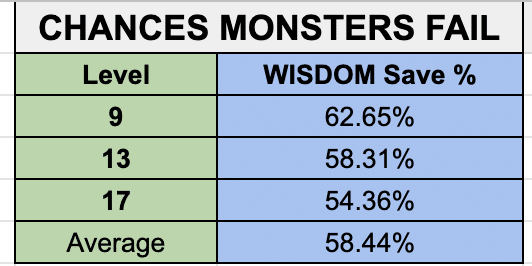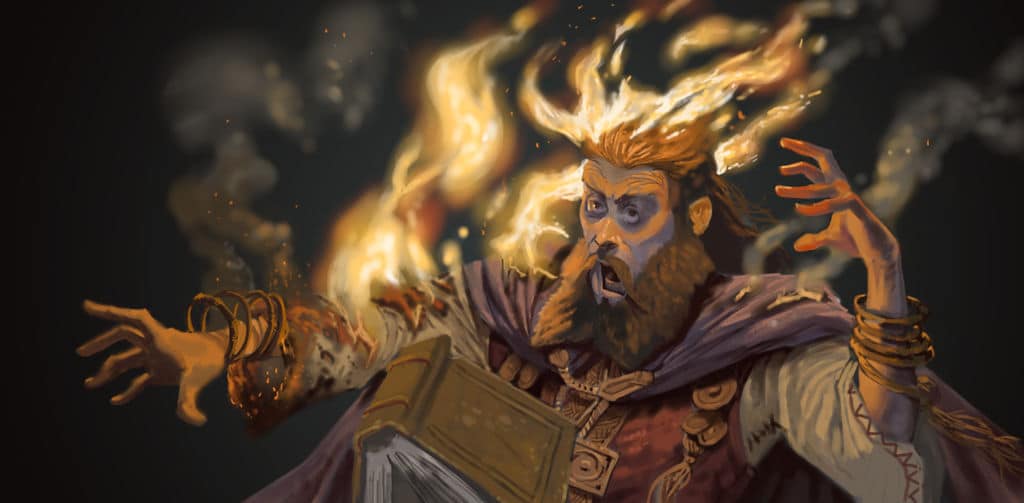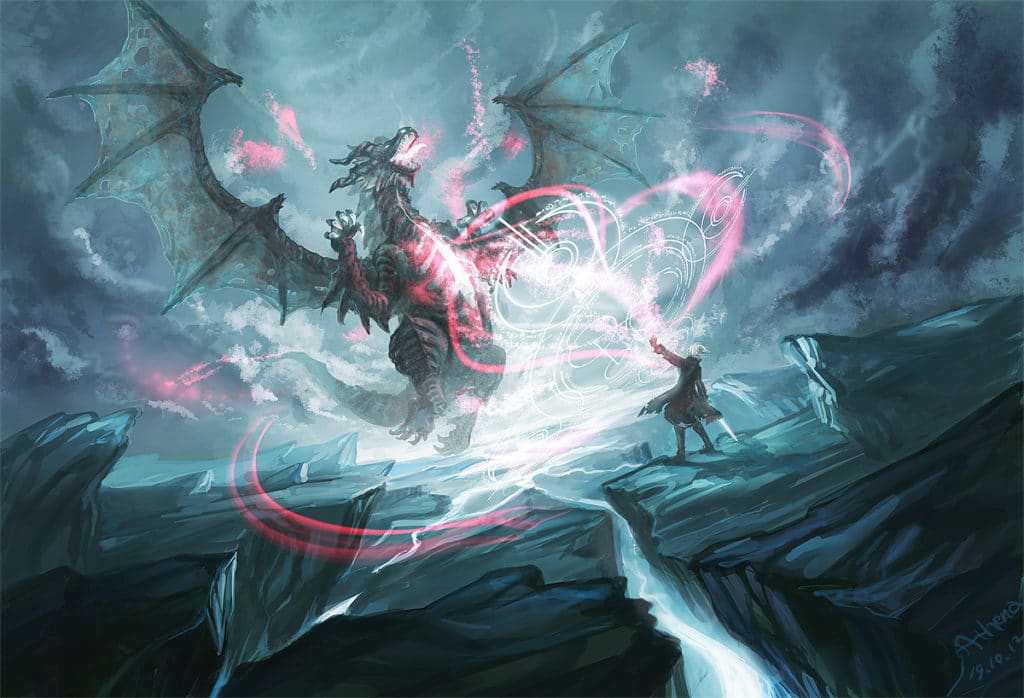Temporal Shunt: 5th-level transmutation
Casting Time: 1 reaction, taken when a creature you can see makes an attack roll or starts to cast a spell
Range: 120 feet
Components: V, S
Duration: 1 round
Temporal Shunt: You target the triggering creature, which must succeed on a Wisdom saving throw or vanish, being thrown to another point in time and causing the attack to miss or the spell to be wasted. At the start of its next turn, the target reappears where it was or in the closest unoccupied space. The target doesn’t remember you casting the spell or being affected by it.
At Higher Levels. When you cast this spell using a spell slot of 6th level or higher, you can target one additional creature for each slot level above 5th. All targets must be within 30 feet of each other.
Spell Lists. Chronurgy Wizard
Average Save?

If you have read my other articles, you will know that thanks to me analyzing the divination wizard, I have calculated the average chance a monster will fail or pass a save with over 740 monsters used in the calculations.
This means I can predict on average how often a monster will save for fail at certain levels.
As can be seen, the average monster will fail temporal shunt saving throw roughly 58.44% of the time.
While 42.56% of the time, temporal shunt will fail to take effect on monsters.
Be sure to use these numbers when considering your odds when casting spells.
Temporal Shunt Pro’s
- Reaction
- Shut off one round
- Don’t know they were affected
Reaction
Let’s talk about the pro’s.
The biggest bonus is the reaction speed.
The biggest struggle to cast spells is using limited information in a situation to cast the right spell for the scenario.
As such, spells, like temporal shunt, that allow you to react at the last second are the best.
Because being able to react to a scenario will give you the most amount of information possible.
Moreover, by being a reaction, you are not restricted to your turn in combat.
This allows you to influence the board on other people’s turns, and cast 2 spells in one turn!
Therefore, seeing as there are only 6 other wizard spells that use reaction speed, this becomes a solid spell for its rarity.
Shut Off One Round
Now that we have talked about why reaction speed is good, let’s talk about why 5e’s temporal shunts effects are good.
As noted the spell removes the triggered target from existence until the start of their next round.
Meaning if they were to begin their round of combat, this can potentially be negated.
Allowing your party to kill their minions, or set up for another round of combat.
This can also work in your favor in other ways.
Say a key party member is in a dangerous area and needs to survive from multiple enemies this turn.
Force the encounter to change.
You can do this by upcasting at a higher level to target the enemy and your party member.
When you do this, your party member will be moved out of combat for this turn.
Thus, preventing any damage dealt to them.
This allows for your party’s healer or tanks to reach them for support when it is their turn again.
In doing so this spell can work both offensively and defensively.
Don’t Know They Were Affected
This can have a huge impact on the battle for a multitude of reasons.
One, they do not begin to target you after this spell resolves.
Two, they are unaware of any changes that happened on the battlefield.
And three, they are supposed to follow through with their actions beforehand since they were unaware of changes.
Meaning that once they appear they are supposed to begin their round as they planned.
If they were about to cast counterspell, they are supposed to cast it as they are not aware they were bumped out.
This can be very advantageous for you, as you now force them to waste an action following through with their intended goal and not triggering any hate toward your character.
Now do note, that if they were to take the attack action they only need to swing once, afterward they can evaluate you are not there and adjust appropriately with their second or third attack.
But, spell casters suffer more from this as a lot of spells require a main action.
The second thing to note is that while this is rules as intended, DM’s don’t have to follow these rules in favor of a reason they can decide upon.
This means while this last boon is great, it can be limiting with certain DM’s.

Temporal Shunt Con’s
- 5th level spell
- Comes back on next turn
- Limited triggers
5th level spell
Now that you know some of the Pro’s let’s talk about the con’s.
The most obvious disadvantage is that Temporal shunt is a 5th level spell.
At this level you have to choose what to cast, be it animate objects, telekinesis, modify memory, or even hold monster.
These are all strong versatile spells in the right player’s arsenal and greatly impact the board state.
So when looking at pure versatility and control these have over temporal shunt.
To find if it becomes good, it requires more of a look at what the spell limits more than what it does.
Which we will go over now.
Comes Back On Next Turn
While bamping them out for a turn has many upsides, doing it for one turn is rather weak in comparison.
This spell has the largest utility out of almost any 5th level spell.
But when looking at other spells such as hold monster or telekinesis, Temporal Shunt lacks the long-term benefits that many other spells offer.
As a result, this becomes a great panic spell, but with proper planning and knowledge, many of the other spells have better long-term effects for the party.
Limited Triggers
Finally, we have the downside of limited triggers.
The spell is definitely great.
The uses are there, the applications are feasible and significant.
However, this spell can only be cast in response to attack rolls or casting spells.
This makes it a purely combat-oriented spell with very few times you can trigger this in roleplay or utility situations.
Moreover, technically magic items cast spells but because you are casting through an item, you don’t always see the cast.
This means the spell will prove to be ineffective on casters who are casting spells unless you know the spell is coming from the object.
For instance, if you know a person using a 7-foot tall staff is casting a cone of cold through it.
Then the trigger for temporal shunt can be triggered and you can cast the spell to stop them.
But, say you have no idea that the bead they are throwing at you is a bead of fireball.
Then the temporal shunt will not trigger.
Therefore, while a good spell the limited times this spell can trigger can be a real hindrance to the spell.
Applications
- Forced Movement
- Protect Allies
- Mop Up Minions
Forced Movement
While there are some serious downsides to this spell, the practical use of being able to cast 2 spells in a turn has a large amount of potential.
A simple one is forced movement.
For instance, because the temporal shunt in 5e states that, “the target reappears where it was or in the closest unoccupied space.”
You can actually place an object in the location they were and force them to appear in a different location.
This can be useful in times when there are cliffs, walls, or other objects that will hinder the enemy from being in an advantageous situation when reappearing.
One of the cheaper options to do this is to use your reaction to cast Temporal Shunt then on your turn to cast a wall of water to navigate the person to spawn in the area that you are wanting them to be in.
It can prove effective in unique situations and is a fun one to remember.
The second option of using forced movement is to actually just set up things like a force cage, wall of force, or even just group up on the enemy.
Then when he bamps back in, he is trapped in a cage or surrounded by enemies he is forced to move to re-adjust.
This makes the spell great to buy your party time to successfully set up a follow-up that is debilitating to the enemies.
Protect Allies
This was briefly talked about before, but Temporal shunt is also great for protecting allies.
If an enemy is about to kill your ally, you can upcast this spell and target both the enemy and the ally.
Both will return on their turn.
Meaning, if the ally goes first, then they will appear first and get out of there.
Or, if the enemy appears first they will leave the spot in search of the next nearest enemy.\
In this way, you can hedge your bets and both protect your allies and harm your enemies.
Though, it should be noted that temporal shunt does not let you purposely fail a save.
So, your ally cannot choose to fail to get out unless homebrewed in there.
So make sure to discuss with your DM if you plan on doing this beforehand to make it even better.
Mop Up Minions
Finally, we have the most obvious use; mopping up small threats.
Usually, if you need to remove a threat for a round, it is going to be the BBEG.
And, oftentimes, a BBEG has minions.
This usually adds a challenge to the party as now they have to decide to take out the small threats or the big threat?
If you take out the big threat, the little threats damage starts adding up and makes it hard to take out the big threat.
However, if you take care of the little threats, then the big threat runs rampant and destroys the party.
Therefore, by removing the big threat from the board for a turn, you give your party time to take out a large chunk of the small threats.
By doing this it makes it much easier in a fight and the party will be sure to notice.
As a result, as mentioned throughout the article, temporal shunt is best for removing a key threat and removing one of their turns.
In doing so, your party’s combat potential goes up immensely.

Is Temporal Shunt better Than Counterspell?
Once taking a look at all the uses out there.
Temporal Shunt is not better than counterspell.
Rather, it is a great emergency spell to have prepared but will not see action very often; much like featherfall.
This can be a staple for many wizards to the insane combat potential of removing key targets for a turn or protecting allies for a turn.
But, due to the spell’s level, its limited duration, and limited triggers, this is an okay spell that will be great 10% of the time but a wasted spot 90% of the time.
Let me know your thoughts in the comments, is it as good as counterspell?
Or more akin to Feather Fall?
Great sometimes but dead a lot of the other times.
Though, if you are looking for a good emergency spell, rope trick is a great choice!
I go over it in detail in my article linked above and has great examples, with a step by step reasoning on why rope trick is a great spell.
Have a wonderful day!


Pingback: Tether Essence 5e Guide: With 3 Unique Uses - Wizard Of The Tavern
Pingback: Reality Break 5e: How Good Is It? - Wizard Of The Tavern